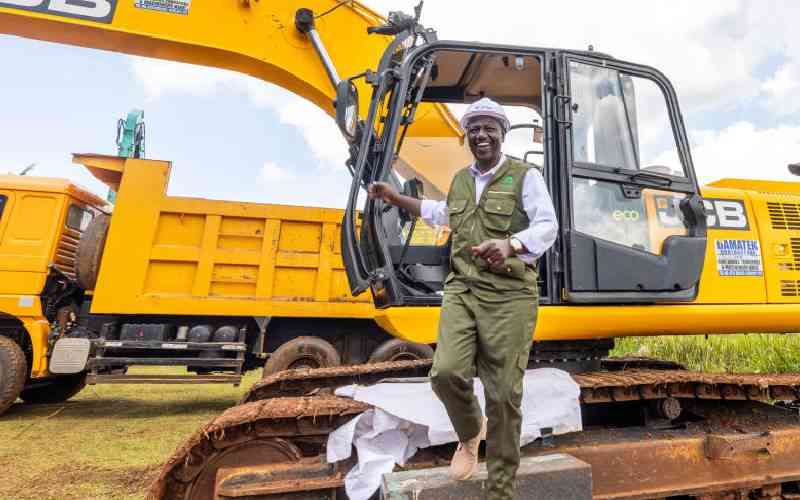By Stella Mwangi
As you approach Eldama Ravine town after a smooth ride over the tarmacked Nakuru-Ravine road, a gush of cool, sweet air refreshingly hits the face.
 |
Joseph Cheruiyot, the town council’s chairman during the interview.
|
Nubians, who worked for British soldiers and transporters, established the town in1887.
Eldama Ravine, for many years thereafter, an administrative town and headquarters of Naivasha Province that was under the administration of Uganda.
After independence the town was reverted to Kenya. Baringo County Council administered Eldama Ravine until 1992 when it was upgraded to a town council.
Now it is the headquarters of Koibatek District but nothing much seems to have changed.
The name ‘Eldama’ is a Maasai word meaning a narrow gorge or shimoni in Kiswahili. The town was better known as ‘Shimoni’ in the colonial days.
Name’s origin
This name came about due to the presence of a steep-sided gorge along which the Eldama Ravine River flowed.
It stretched for two kilometres downstream and is nearly 30m deep. The area within the town is divided into a number of lesser ridges and ravines.
Despite being a British settlement for years and situated near Kenya’s major tourist attraction sites such as Lakes Bogoria and Baringo, the town has for the last decade not recorded much growth.
So far, the town has one commercial bank and two co-operative societies. The real estate industry is still untapped with no residential houses or commercial buildings available for rent.
This may have locked out many potential investors, especially financial institutions that could spur development.
Huge tracts of land lie idle and undeveloped in the town, belonging to absentee landlords that nobody seems to know.
Stay informed. Subscribe to our newsletter
Idle land
Abdul Musa, a Ravine ward councillor, feels the town could expand rapidly if landowners were to develop it instead of letting it lie idle.
Most them, he says, prefer to sell the land rather than develop it themselves.
"When I started there were less than ten shops in the town though the number has risen significantly. Many traders would like to do business in the town but cannot afford to buy land to build shops," he says.
Eldama Ravine is about 60km north west of Nakuru town with an estimated 32,192 people. The population increased during the post-election period after people from neighbouring towns took refuge there. Most displaced persons have since found a safe haven and settled in Ravine.
The town is well connected to other areas with a wide road network and is easily accessible from Kabarnet, Nakuru and Eldoret, among other areas.
Source of livelihood
The industrial sector was greatly affected by the closure of Kenya Co-operative Creameries (KCC) and by a ban on logging.
"Saw milling was a major source of livelihood for the people but since 1999 when the ban was effected many saw millers who had carved a niche here moved to other towns," says Musa, who is also one of the first businessmen in the town.
With the revival of KCC, agriculture is looking up given that dairy farming is a major human activity in the region.
Establishment of two flower farms Karen Roses and Mosop Roses, has also created more than 3,000 jobs.
A poor sewerage system has, however, locked out many potential investors.
The system consists mainly of pit latrines and septic tanks that are not properly maintained. A proposed sewage site is yet to be developed for lack of funds.
 The Standard Group Plc is a
multi-media organization with investments in media platforms spanning newspaper
print operations, television, radio broadcasting, digital and online services. The
Standard Group is recognized as a leading multi-media house in Kenya with a key
influence in matters of national and international interest.
The Standard Group Plc is a
multi-media organization with investments in media platforms spanning newspaper
print operations, television, radio broadcasting, digital and online services. The
Standard Group is recognized as a leading multi-media house in Kenya with a key
influence in matters of national and international interest.
 The Standard Group Plc is a
multi-media organization with investments in media platforms spanning newspaper
print operations, television, radio broadcasting, digital and online services. The
Standard Group is recognized as a leading multi-media house in Kenya with a key
influence in matters of national and international interest.
The Standard Group Plc is a
multi-media organization with investments in media platforms spanning newspaper
print operations, television, radio broadcasting, digital and online services. The
Standard Group is recognized as a leading multi-media house in Kenya with a key
influence in matters of national and international interest.







